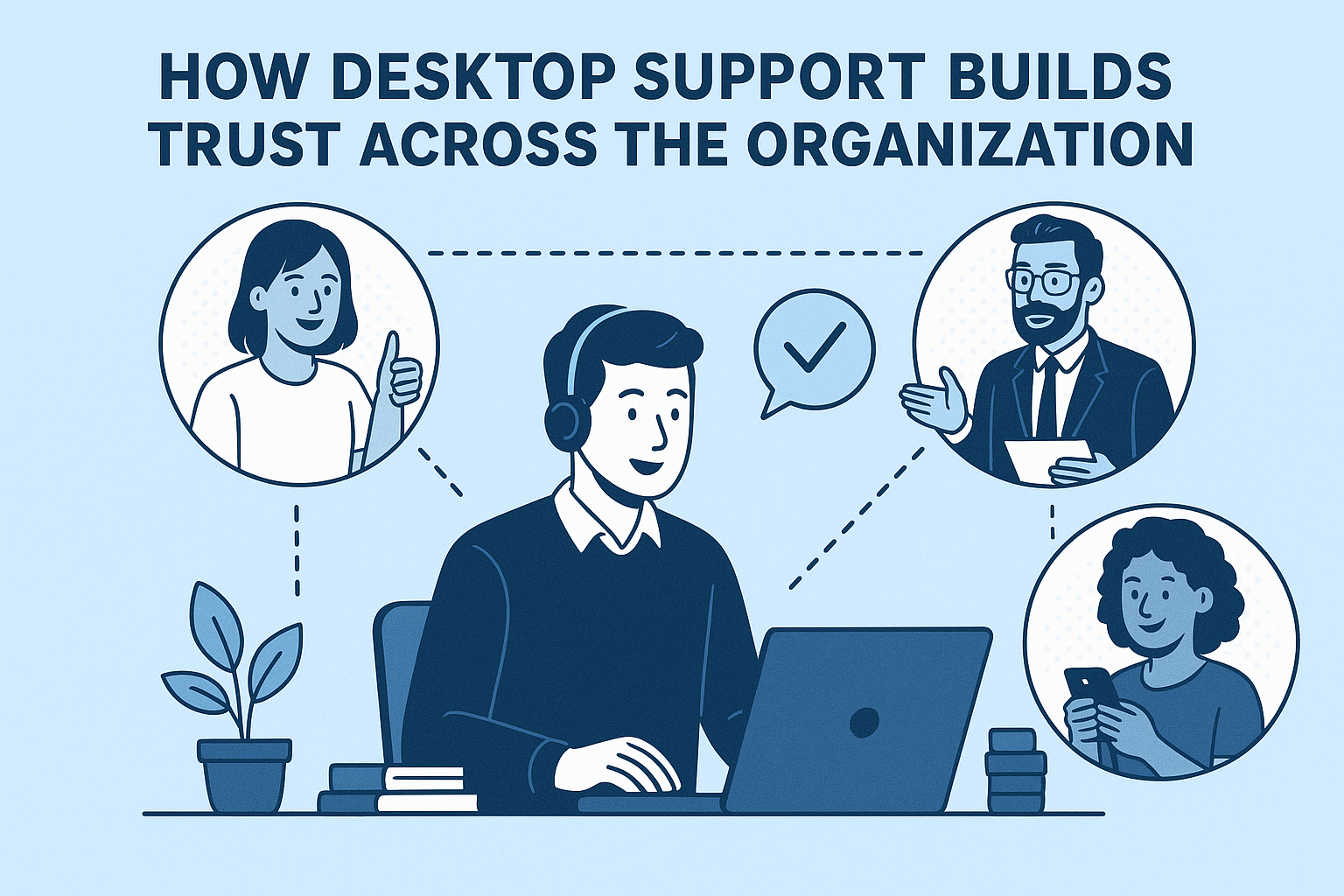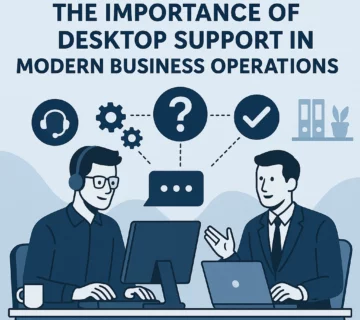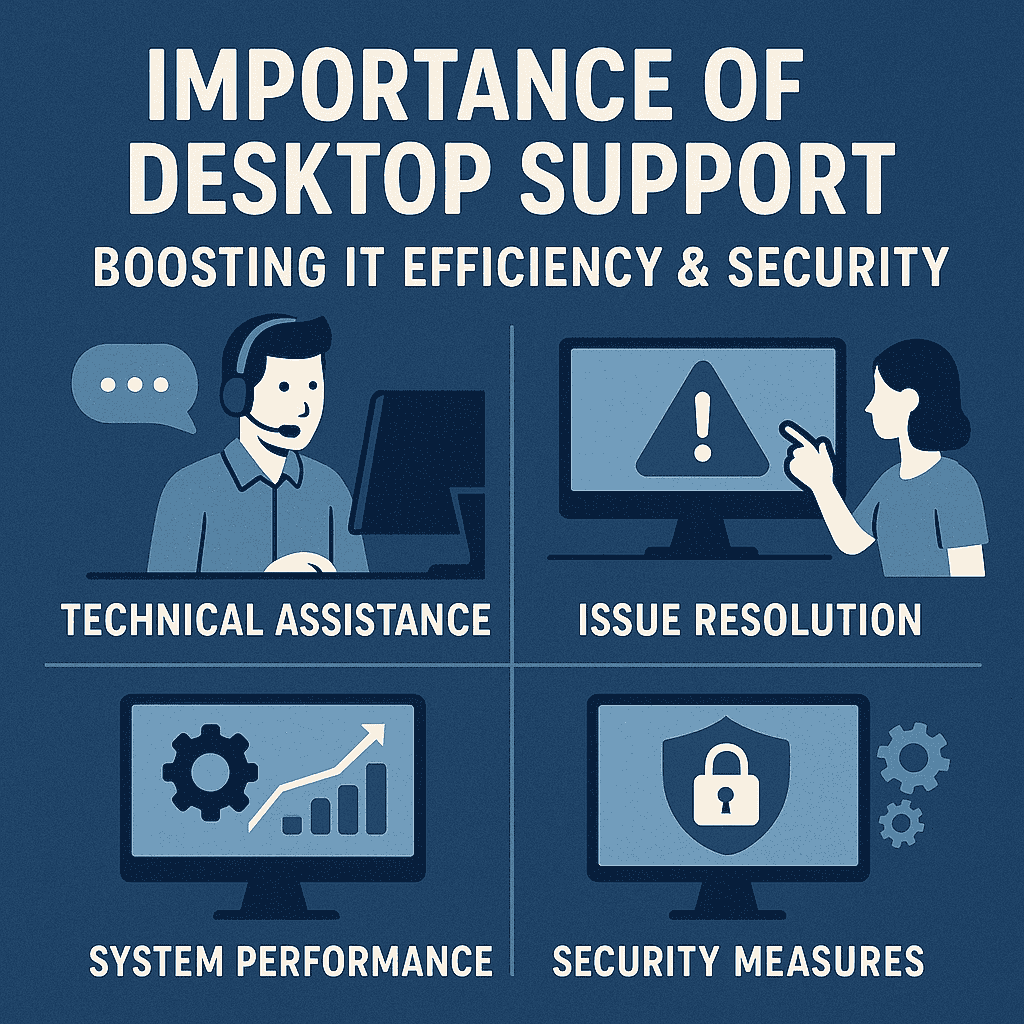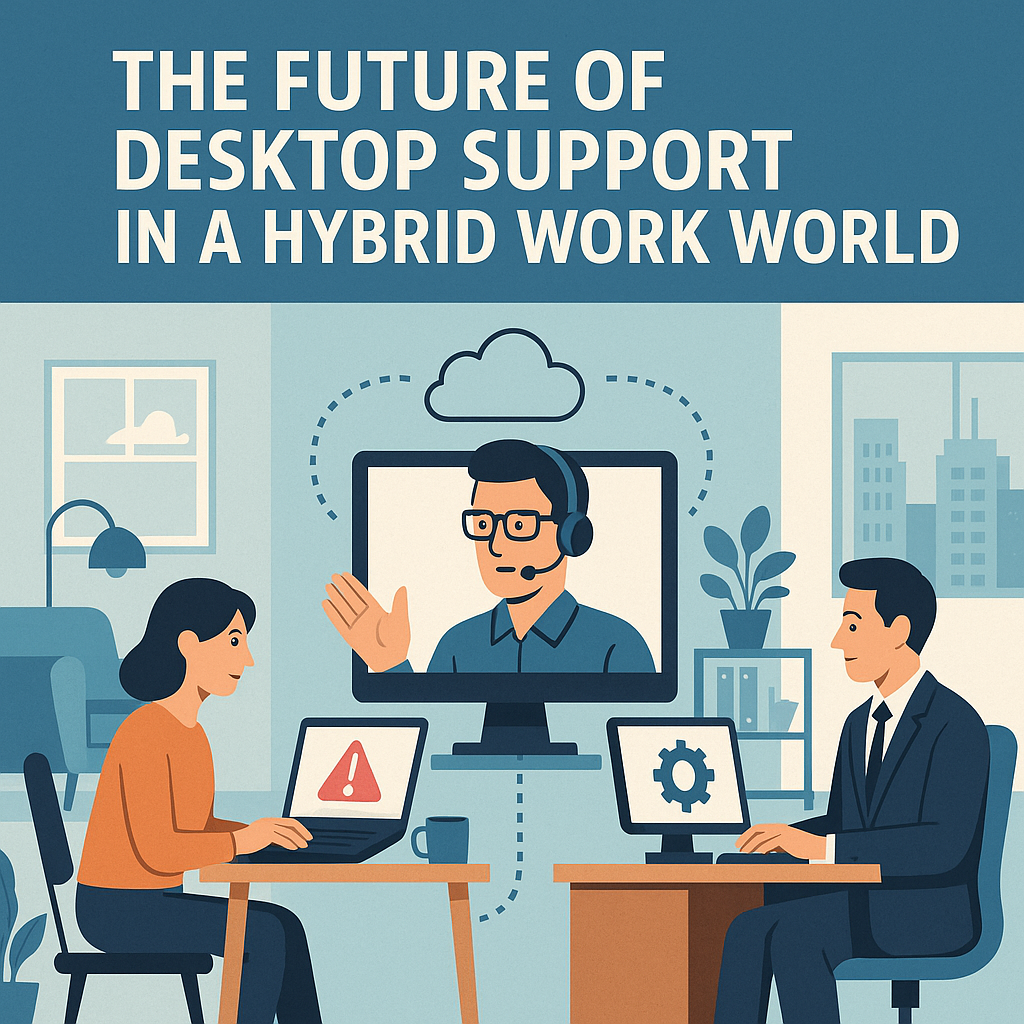How Desktop Support Builds Trust Across the Organization

In technology-driven workplace, desktop support teams serve as the invisible backbone that keeps organizations running smoothly. While their work often goes unnoticed when everything functions perfectly, these unsung heroes play a crucial role in building and maintaining trust throughout the entire organization.
The Foundation of Organizational Trust
Trust within an organization extends far beyond interpersonal relationships between colleagues. It encompasses the confidence employees have in their tools, systems, and the people who maintain them. Desktop support professionals occupy a unique position in this ecosystem, serving as the bridge between complex technology and everyday users.
When employees know they can rely on their technology to work seamlessly, they develop confidence not just in their tools, but in the organization’s ability to support their success. This technological reliability becomes a fundamental pillar of workplace trust.
Building Confidence Through Consistent Service
Reliability as a Trust Builder
Desktop support teams build trust through consistent, reliable service delivery. When employees experience quick response times, effective problem resolution, and minimal downtime, they develop confidence in both the IT department and the organization as a whole.
This reliability manifests in several ways. First, predictable service levels create expectations that users can depend on. When desktop support consistently meets or exceeds these expectations, trust naturally develops. Second, transparent communication about issues, timelines, and solutions helps users feel informed and valued rather than left in the dark.
For organizations considering desktop support outsourcing, this reliability becomes even more critical as external providers must prove their trustworthiness from day one.
Proactive Problem Prevention
The most trusted desktop support teams don’t just react to problems—they prevent them. By implementing proactive monitoring, regular maintenance schedules, and preventive measures, these teams demonstrate their commitment to user success before issues arise.
This proactive approach sends a powerful message throughout the organization: the IT department is invested in preventing disruptions to productivity rather than simply fixing problems after they occur. This forward-thinking mindset builds tremendous trust and credibility.
Fostering Communication and Transparency
Clear Communication Channels
Effective desktop support teams establish clear, accessible communication channels that make it easy for users to request help and receive updates. Whether through ticketing systems, help desk portals, or direct communication methods, these channels become lifelines that connect users with the support they need.
Modern desktop support software tools enable teams to maintain consistent communication across multiple channels, ensuring users can reach support through their preferred method while maintaining service quality standards.
The key to building trust through communication lies in consistency and clarity. Users should always know how to reach support, what to expect in terms of response times, and how their issues will be handled. This transparency eliminates uncertainty and builds confidence in the support process.
Setting and Managing Expectations
Trust flourishes when expectations are clearly set and consistently met. Desktop support teams that excel at building organizational trust are masters at managing expectations. They provide realistic timelines, explain complex technical issues in understandable terms, and keep users informed throughout the resolution process.
When unexpected challenges arise, trusted support teams communicate proactively rather than leaving users wondering about the status of their requests. This open communication style demonstrates respect for users’ time and needs.
Empowering Employees Through Technology
Enabling Productivity
Desktop support teams build trust by ensuring employees have the tools and technology they need to be productive. This goes beyond simply fixing broken computers—it involves understanding how different roles use technology and optimizing systems to support those specific needs.
When employees feel empowered by their technology rather than hindered by it, they develop trust in the organization’s commitment to their success. Desktop support teams facilitate this empowerment by maintaining well-functioning systems, providing appropriate software and hardware, and ensuring smooth technology transitions.
Training and Knowledge Sharing
Trusted desktop support teams don’t just solve problems—they educate users to prevent future issues. By providing training, sharing knowledge, and teaching users how to troubleshoot common problems themselves, support teams demonstrate their commitment to user empowerment rather than dependency.
This educational approach builds trust by showing users that the IT department wants them to succeed independently, not remain reliant on constant support. It also creates a sense of partnership rather than a service provider-customer relationship. For those interested in pursuing this field, understanding how to become a desktop support technician often starts with developing both technical skills and this educational mindset.
Strengthening Interdepartmental Relationships
Breaking Down Silos
Desktop support teams often serve as connectors between different departments, helping to break down organizational silos. When support staff understand the unique needs of various departments and facilitate technology solutions that improve cross-departmental collaboration, they contribute to overall organizational cohesion.
This connecting role builds trust by demonstrating that IT understands and values the work of all departments, not just technology-focused teams. It shows a commitment to the organization’s overall success rather than just technical excellence.
Collaborative Problem Solving
The most trusted desktop support teams approach problem-solving collaboratively, working with users to understand not just the technical symptoms but the business impact of issues. This collaborative approach builds trust by showing users that their concerns are understood and valued.
Rather than dictating solutions from a purely technical perspective, these teams engage users in the problem-solving process, explaining options and involving them in decision-making where appropriate. This inclusive approach fosters trust and buy-in for technical solutions.
The Rise of Remote Support Solutions
Modern organizations increasingly rely on remote desktop support outsourcing to maintain continuous service coverage. A qualified remote desktop support outsourcing company can provide seamless support across time zones and geographic boundaries, ensuring users receive help when they need it most.
The implementation of 24/7 remote desktop support outsourcing has become particularly valuable for global organizations, allowing them to maintain consistent service levels regardless of location or time of day. Organizations that outsource remote desktop support often find they can provide better coverage while potentially reducing costs.
Remote support capabilities have proven essential in building trust, especially as hybrid and remote work models become more prevalent. Users need to know they can receive the same quality support whether they’re in the office or working from home.
Measuring and Maintaining Trust
Feedback Mechanisms
Building trust requires ongoing attention and measurement. Desktop support teams that excel at building organizational trust implement robust feedback mechanisms to understand how well they’re serving users and where improvements might be needed.
Regular surveys, feedback sessions, and informal check-ins help support teams stay connected with user needs and perceptions. This feedback-driven approach demonstrates a commitment to continuous improvement and user satisfaction.
Continuous Improvement
Trust is not built once and forgotten—it requires ongoing cultivation. The most trusted desktop support teams embrace continuous improvement, regularly evaluating their processes, tools, and approaches to find ways to better serve their users.
This commitment to improvement shows users that the support team is always working to provide better service, which builds long-term trust and confidence in the IT department’s capabilities and intentions.
The Ripple Effect of Trust
Organizational Culture Impact
When desktop support teams successfully build trust, the impact extends far beyond IT services. This trust contributes to a positive organizational culture where employees feel supported and valued. It creates an environment where people are willing to try new technologies, suggest improvements, and collaborate more effectively.
The trust built by desktop support teams often serves as a model for other departments, demonstrating how consistent service, clear communication, and user-focused approaches can build strong relationships throughout the organization.
Business Outcomes
Organizations with trusted desktop support teams often see improved business outcomes. Higher employee satisfaction, increased productivity, reduced downtime, and better technology adoption rates all contribute to organizational success. These tangible benefits demonstrate the real value of investing in trust-building through desktop support services.
Overcoming Common Trust Challenges
Addressing Past Negative Experiences
Some organizations struggle with legacy trust issues stemming from poor past experiences with IT support. Building trust in these environments requires patience, consistency, and a commitment to demonstrating change through actions rather than words.
Desktop support teams in these situations must be prepared for skepticism and work extra hard to prove their reliability and commitment to user success. This often means exceeding expectations initially to overcome negative perceptions.
Managing Resource Constraints
Limited resources can make it challenging to provide the level of service that builds trust. However, even resource-constrained teams can build trust through transparent communication about limitations, creative problem-solving, and a genuine commitment to helping users within available means.
The key is being honest about constraints while still demonstrating a sincere desire to help and improve service whenever possible.
Best Practices for Trust Building
Consistency in Service Delivery
The foundation of trust is consistency. Desktop support teams should strive to deliver the same high-quality service regardless of who is requesting help, when they request it, or what type of issue they’re experiencing.
Personal Connection
While desktop support is often viewed as a technical function, the human element is crucial for building trust. Support staff who take time to understand users as individuals, remember their preferences and past issues, and show genuine concern for their success build stronger trust relationships.
Professional Development
Investing in the professional development of desktop support staff pays dividends in trust building. Well-trained, knowledgeable staff who stay current with technology trends and best practices inspire more confidence and trust from users.
Future Considerations
Evolving Technology Landscape
As technology continues to evolve rapidly, desktop support teams must adapt their trust-building strategies to new challenges and opportunities. Cloud computing, remote work technologies, and artificial intelligence all present new ways to build trust while also creating new potential trust challenges.
Remote Work Implications
The shift toward remote and hybrid work models has changed how desktop support teams build trust. Virtual interactions require different approaches to relationship building, and support teams must find new ways to provide the personal touch that builds trust in remote environments.
Frequently Asked Questions
1. What is the most important factor in building trust through desktop support?
Consistency is the most critical factor. Users need to know they can rely on their desktop support team to provide predictable, high-quality service every time they need help. This reliability forms the foundation of trust.
2. How can desktop support teams measure the trust they’ve built?
Trust can be measured through user satisfaction surveys, response time metrics, repeat request rates, and informal feedback. Regular pulse surveys asking specifically about trust and confidence in IT services provide valuable insights.
3. What should desktop support teams do when they make mistakes?
When mistakes occur, transparency and quick corrective action are essential. Teams should acknowledge errors honestly, explain what went wrong, outline steps to prevent recurrence, and follow through on commitments to improve.
4. How long does it typically take to build trust in an organization?
Building trust is an ongoing process that varies by organization and past experiences. In environments with no negative history, trust can begin developing within the first few positive interactions. In organizations with past trust issues, it may take months or even years of consistent positive service to fully rebuild trust.
5. Can small desktop support teams build the same level of trust as larger teams?
Absolutely. Trust is built through consistency, communication, and genuine care for user success rather than team size. Smaller teams often have advantages in building personal relationships and providing more personalized service.
6. What role does leadership play in desktop support trust building?
Leadership plays a crucial role by setting service standards, providing necessary resources, supporting staff development, and modeling trust-building behaviors. Leaders who prioritize user satisfaction and invest in their support teams create environments where trust can flourish.
7. How can desktop support teams build trust with non-technical users who may be intimidated by technology?
Building trust with non-technical users requires patience, clear communication in non-technical language, and a genuine commitment to education and empowerment. These users often become the strongest advocates for trusted support teams once they feel comfortable and supported.
8. What are the biggest threats to organizational trust in desktop support?
9. The biggest threats include inconsistent service delivery, poor communication, failure to follow through on commitments, and treating users as problems rather than people. Security breaches and significant system failures can also damage trust if not handled properly.
10. How can remote desktop support teams build the same level of trust as on-site teams?
Remote teams can build trust through excellent communication, reliable remote access tools, proactive outreach, and finding creative ways to provide personal touches in virtual interactions. Video calls, regular check-ins, and responsive communication help bridge the physical distance gap.
11. What should organizations do if trust in their desktop support has been damaged?
Rebuilding damaged trust requires acknowledging past problems, making concrete changes to service delivery, consistently exceeding expectations, and being patient as trust slowly rebuilds through positive experiences. Leadership support and potentially bringing in new team members or leaders may also be necessary.




No comment